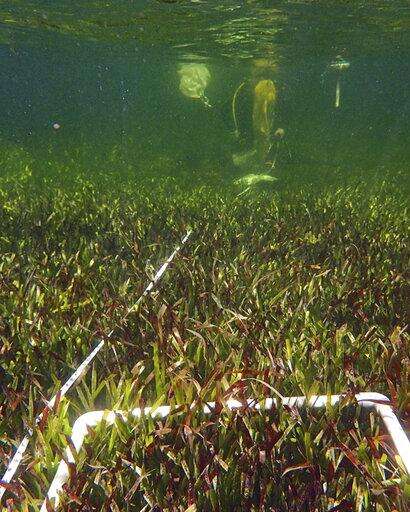This August 2019 photo provided by The University Of Western Australia shows part of the Posidonia australis seagrass meadow in Australia's Shark Bay. According to a report released on Wednesday, June 1, 2022, genetic analysis has revealed that the underwater fields of waving green seagrass are a single organism covering 70 square miles (180 square kilometers) through making copies of itself over 4,500 years. (Rachel Austin/The University Of Western Australia via AP)
The Associated Press
WASHINGTON (AP) - Scientists have discovered the world's largest plant off the Australia coast - a seagrass meadow that has grown by repeatedly cloning itself.
Genetic analysis has revealed that the underwater fields of waving green seagrass are a single organism covering 70 square miles (180 square kilometers) through making copies of itself over 4,500 years.
The research was published Wednesday in Proceedings of the Royal Society B.
Scientists confirmed that the meadow was a single organism by sampling and comparing the DNA of seagrass shoots across the bed, wrote Jane Edgeloe, a study co-author and marine biologist at the University of Western Australia.
A variety of plants and some animals can reproduce asexually. There are disadvantages to being clones of a single organism - such as increased susceptibility to diseases - but 'œthe process can create '~hopeful monsters''ť by enabling rapid growth, the researchers wrote.
The scientists call the meadow of Poseidon's ribbon weed 'œthe most widespread known clone on Earth," covering an area larger than Washington.
Though the seagrass meadow is immense, it's vulnerable. A decade ago, the seagrass covered an additional seven square miles, but cyclones and rising ocean temperatures linked to climate change have recently killed almost a tenth of the ancient seagrass bed.
___
The Associated Press Health and Science Department receives support from the Howard Hughes Medical Institute's Department of Science Education. The AP is solely responsible for all content.
This October 2009 photo provided by The University Of Western Australia, shows part of the Posidonia australis seagrass meadow at Peron Peninsula in Australia's Shark Bay. According to a report released on Wednesday, June 1, 2022, genetic analysis has revealed that the underwater fields of waving green seagrass are a single organism covering 70 square miles (180 square kilometers) through making copies of itself over 4,500 years. (Angela Rossen/The University Of Western Australia via AP)
The Associated Press

This June 2022 photo provided by The University Of Western Australia shows sampling efforts of the Posidonia australis seagrass meadow in Australia's Shark Bay. According to a report released on Wednesday, June 1, 2022, genetic analysis has revealed that the underwater fields of waving green seagrass are a single organism covering 70 square miles (180 square kilometers) through making copies of itself over 4,500 years. (Rachel Austin/The University Of Western Australia via AP)
The Associated Press
This November 2018 photo provided by The University Of Western Australia shows part of the Posidonia australis seagrass meadow in Australia's Shark Bay. According to a report released on Wednesday, June 1, 2022, genetic analysis has revealed that the underwater fields of waving green seagrass are a single organism covering 70 square miles (180 square kilometers) through making copies of itself over 4,500 years. (Sahira Bell/The University Of Western Australia via AP)
The Associated Press